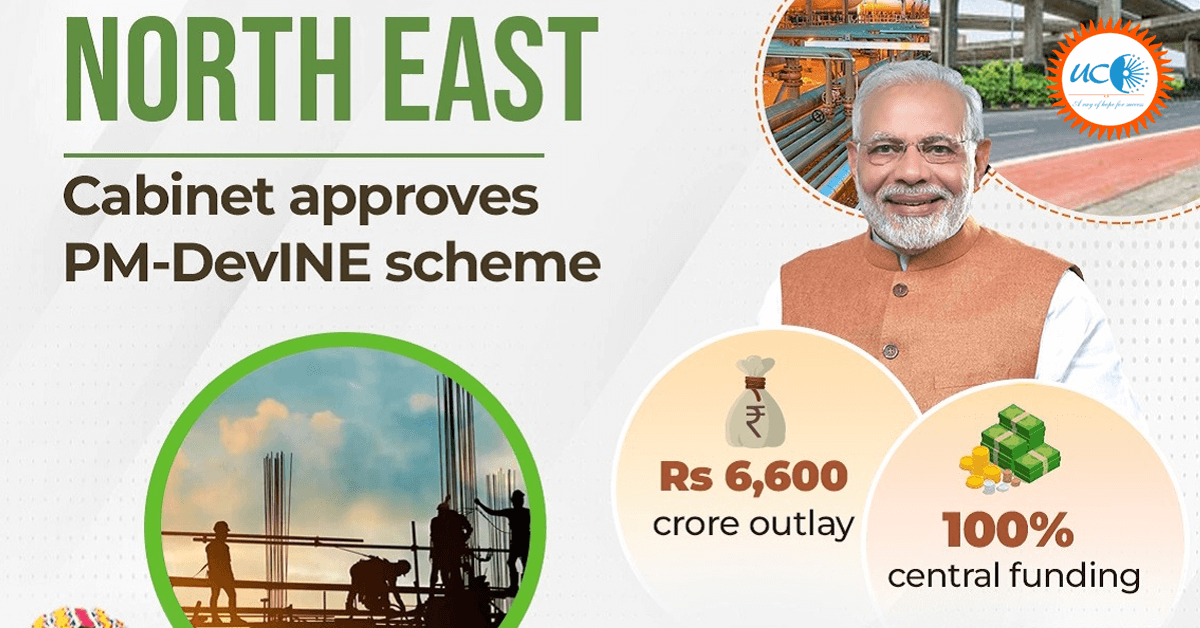Prime Minister’s Development Initiative for North East Region (PM-DevINE)
Why in News?
Recently, the Union Cabinet approved a new Scheme, Prime Minister’s Development Initiative for North East Region (PM-DevINE).
- PM-DevINE was announced in the Union Budget 2022-23 to address development gaps in the North Eastern Region (NER).
What is PM-DevINE Scheme?
- About:
- It is a Central Sector Scheme with 100% Central funding.
- The new scheme, to be implemented during the remaining four years of the 15th Finance Commission from 2022-23 to 2025-26 has an outlay of Rs.6,600 crore.
- The PM-DevINE is in addition to the quantum of resources available for the development of the NE region. It will not be a substitute for existing central and state schemes.
- Implementation:
- The scheme will be implemented by the Ministry of Development of the North Eastern Region through North Eastern Council or Central Ministries/ agencies.
- Objectives:
- Fund infrastructure convergently, in the spirit of PM Gati Shakti
- Support social development projects based on the felt needs of the NER
- Enable livelihood activities for youth and women
- Fill the development gaps in various sectors
What is the Significance of the North East for India?
- Strategic Significance: North-East India is the gateway to South-East Asia and beyond. It is India’s land bridge to Myanmar.
- India’s Act East Policy places the northeastern states on the territorial frontier of India’s eastward engagement.
- Cultural Significance: North East India is one of the most culturally diverse areas of the world. It is home to over 200 tribes. Popular festivals include the Hornbill Festival of Nagaland, Pang Lhabsol of Sikkim, etc.
- North-east India is a Dowry-Free Zone.
- The rich tapestry of cultures of the Northeast is reflected in its highly developed Folk dance forms like Bihu (Assam).
- Manipur has a tradition of worshipping nature in sacred groves, called UmangLai.
- Economic Significance: Economically, the Region is rich in natural resources of “TOT” (Tea, Oil, and Timber).
- It is a veritable powerhouse with a potential of 50000 MW of hydroelectric power and an abundant reserve of fossil fuels.
- Ecological Significance: North East is a part of the Indo-Burma biodiversity hotspot. It represents one of the highest avian and plants biodiversity of the Indian subcontinent.
- This area has the prestige of having all the bear species present in India.
What are the Current Challenges Pertaining to North-East India?
- Isolation From the Rest of India: The region’s accessibility has always remained weak due to geographical reasons and underdeveloped transport links with the rest of India.
- Lack of Efficient Infrastructure: Infrastructure i.e., physical (like roadways, waterways, energy, and so on) as well as social infrastructure (for instance educational institutions, and health facilities) plays an important role in human development and economic growth of any region
- One of the reasons for the economic backwardness of the North-Eastern states is the poor state of basic infrastructural facilities.
- Slow Pace of Industrial Growth: North-East India has remained historically underdeveloped in terms of industrial growth.
- Territorial Conflicts: There are existing inter-state and international territorial conflicts within the Northeast that are often based on historical border disputes and differing ethnic, tribal, or cultural affinities. Example: Assam-Mizoram Border Dispute.
- Insurgency and Political Issues: Insurgency or terrorism is a political weapon and is often the result of accumulated anger due to political, economic, and social causes.
- The North-Eastern states have witnessed a rise in insurgent activities and regional movements with a feeling of exploitation and alienation from other Indian states.
What are the Major Infrastructure Projects in the Northeast?
- Rail, Road, and Air Connectivity:
- 4,000 km of roads, 20 railway projects for 2,011 km, and 15 air connectivity projects are being developed.
- Waterways Connectivity:
- National waterways on the Ganges, Brahmaputra and Barak rivers (National Waterways (NW)-1 on the Ganges, NW-2 on the Brahmaputra, and NW-16 on Barak) are under development to provide better connectivity.
- Eastern Waterways Connectivity Transport Grid:
- It will connect the northeast with the rest of India by providing 5,000 km of navigable waterways.
- North Eastern Region Power System Improvement Project (NERPSIP):
- (NERPSIP) is a major step towards economic development of the North Eastern Region through the strengthening of Intra – State Transmission and Distribution systems.
- The government is also emphasizing projects related to power transmission and distribution, mobile networks, 4G, and broadband connectivity.
Way Forward
- Investing in infrastructure would generate employment and would play a major role in thwarting secessionist movements in the Northeast region.
- India’s North East is surrounded by national and international borders, so, national and international infrastructure development will be the best choice for inclusive development in India’s Northeast.
UPSC Civil Services Examination, Previous Year Questions (PYQs)
- Cross-border movement of insurgents is only one of the several security challenges facing the policing of the border in North-East India. Examine the various challenges currently emanating across the India- Myanmar border. Also, discuss the steps to counter the challenges. (2019)






